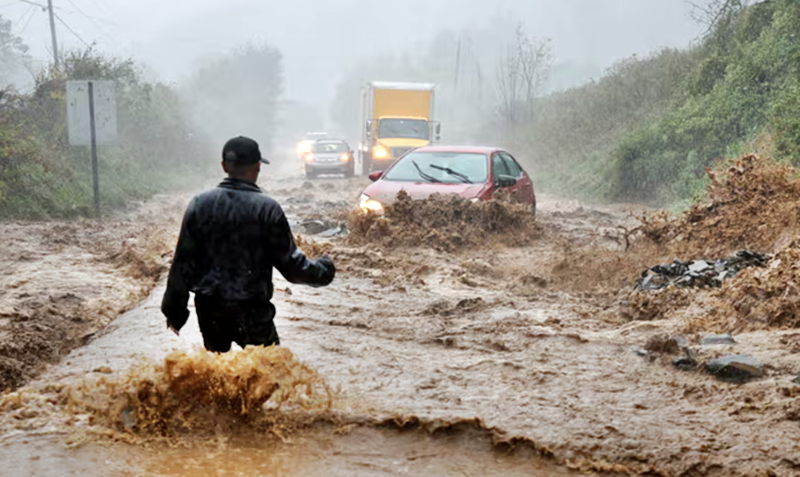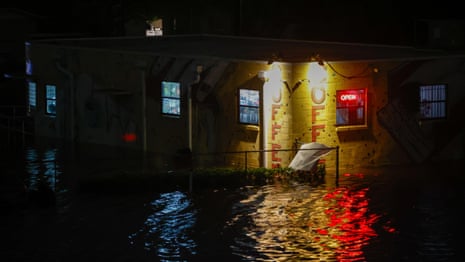Hurricane Helene: dozens dead as storm pummels south-eastern US

By Guardian-Ramon Antonio Vargas/Richard Luscombe - Fri 27 Sep 2024
Helene left a dizzying path of destruction as it raged across the south-east United States on Friday, killing at least 40 people across four states, causing dangerous flooding and leaving millions without power.
Residents in several states suffer power outages and heavy flooding as officials warn of ‘very dangerous environment’. Death toll from Helene rises to above 40 as it continues inward – as it happenedRead more
The storm – which registered maximum sustained winds of 140mph – crashed ashore late on Thursday in north-western Florida as a potent category 4 hurricane. It weakened to a tropical storm and then to a depression as it moved across Georgia as well as the Carolinas on Friday afternoon, when residents whose communities experienced Helene’s peak effects more directly were only just beginning to fathom the recovery process ahead.
The storm sparked lethal damage across four states. At least 17 people died in South Carolina, including two firefighters killed when their vehicle was struck by a tree before sunrise, officials said.
Another 15 people were killed in Georgia, said Garrison Douglas, a spokesperson for the state’s governor, Brian Kemp.
Five people were killed in Florida’s Pinellas county, which includes the Tampa Bay area, with two of those deaths occurring by drowning. A number of the deaths involved trees falling on residences.
Among the dead were several children: a four-year-old girl who died in Claremont, North Carolina, in a car accident in heavy rain; and a seven-year-old boy and a four-year-old girl who died when a tree fell on their home in Washington county, Georgia.
Tornadoes hit some areas, including one in Nash county, North Carolina, that critically injured four people.
Authorities had predicted danger even as the storm weakened, as it continued to produce catastrophic flooding. Some areas received more than a foot of rain. Rescuers were racing on Friday to save people from the waters.
One dramatic scene in Tennessee reportedly involved more than 50 patients and staff at the state’s Unicoi county hospital, who were stranded on the roof while surrounded by rising floodwaters. Emergency vehicles were washed away as they attempted rescues, while helicopters that had initially been held back by high winds, were evacuating people on Friday afternoon. The patients and staff were eventually brought to safety.
Officials in several states warned people who were stuck to await rescue crews, as floodwater could contain live wires, sewage, sharp objects and other debris. Some areas had become only accessible by boat.
At several points on Friday afternoon, officials urged residents to evacuate over concerns that local dams would not sustain the pressure. In western North Carolina, near the border with Tennessee, Rutherford county emergency officials warned residents near the Lake Lure Dam just before noon to immediately evacuate to higher ground, saying: “Dam failure imminent.”
And on Friday afternoon, North Carolina’s Cocke county mayor, Rob Mathis, warned people in the vicinity to evacuate immediately after the Walters Dam in the community of Waterville suffered a catastrophic failure. In a post on Facebook, officials later assured that there had not been a catastrophic failure at the dam, adding that the false alarm had come from the emergency management agency.
Meanwhile, millions of people across the country were out of power. As of early Friday evening, about 1.1m households and businesses in Florida were without power, though later the number had fallen to about 708,000. South Carolina was reporting 1.2m power outages, Georgia had about 920,000, and North Carolina had approximately 870,000, according to poweroutage.us. Large swaths of Tennessee, Kentucky, Virginia and Ohio were also out, and the Virginia governor said 241,000 customers in his state were out of power.
5am EDT Friday Key Messages for Tropical Storm #Helene:
— National Hurricane Center (@NHC_Atlantic) September 27, 2024
Catastrophic, life-threatening, record-breaking flash & urban flooding. As Helene continues moving inland, damaging wind gusts will continue, particularly over high terrain southern Appalachians. https://t.co/XtkxtGDQLT pic.twitter.com/IayaD7DaAW
Helene made landfall at about 11.10pm in Florida’s sparsely populated Big Bend area, home to fishing villages and vacation hideaways where the state’s Panhandle and peninsula meet.
Social media site users watched in horror as video showed sheets of rain lashing Perry, Florida, near Helene’s landfall. Winds tore siding from buildings in almost complete darkness. One local news station recorded a home as it flipped over.
The National Hurricane Center (NHC) conducted a preliminary assessment of Helene’s storm surge in Florida, and it indicated that water levels reached more than 15ft above normal where the storm came ashore.
Drone video from the storm chaser Aaron Rigsby showed residences that collapsed and were damaged amid storm surge in the Florida community of Steinhatchee. Florida’s Tampa Bay took on about 10ft of storm surge and was among the state’s badly inundated communities.
The Florida governor, Ron DeSantis, urged residents to prepare themselves for the likelihood that Helene’s death toll would rise as communities complete damage assessments in the storm’s aftermath. But he also said the state’s rescue crews had ultimately kept that number as low as possible by performing “thousands of missions” overnight.
In Georgia, Brian Kemp, the governor, warned residents Helene had left “a very dangerous environment” in its wake. “One of our finest has lost his life trying to save others,” Kemp said.
Atlanta was drenched, leaving some neighborhoods so flooded that only car roofs could be seen poking out of the water. The city had been under a rare flash flood emergency warning.
A Georgia electrical utility group warned of “catastrophic” damage to the state’s utility infrastructure, with more than 100 high-voltage transmission lines damaged.
In Valdosta, Georgia, a city of 55,000 near the state’s border with Florida, Rhonda Bell and her husband spent a sleepless night in the downstairs bedroom of their century-old home. She told the Associated Press that an oak tree smashed through the roof of an upstairs bedroom and collapsed on to the living room below.
“I just felt the whole house shake,” said Bell, whose neighbors had roof shingles torn away and fence panels knocked down. “Thank God we’re both alive to tell about it.”

Beyond Florida and Georgia, up to 10in of rain fell in the North Carolina mountains.
“This is one of the worst storms in modern history for parts of … North Carolina,” the state’s governor, Roy Cooper, said. “Our hearts are heavy.”
A mudslide in the Appalachian mountains washed out a section of an interstate at the North Carolina-Tennessee state line. Meanwhile, occupants of homes hit by another mudslide in North Carolina had to wait more than four hours to be rescued, said Ryan Cole, the emergency services assistant director in Buncombe county. His 911 center received more than 3,300 calls in eight hours Friday.
Florida is no stranger to hurricanes, but authorities and residents had been warned Helene would be a disaster of epic proportions.
One sheriff’s office in the state, in Taylor county, asked residents who chose not to evacuate ahead of Helene to write their names, birthdays and other identifying information on their limbs in permanent marker. “So that you can be identified and [your] family notified,” the agency wrote in what was grim advice ahead of the storm.
“I’m going to stay right here at the house,” the state ferry boat operator Ken Wood, 58, told Reuters from coastal Dunedin in Florida, where he planned to ride out the storm with his 16-year-old cat Andy.
Afterwards, he told the agency: “I’ll never do that again, I swear. It was a harrowing experience. It roared all night like a train. It was unnerving. The house shook … next time, we leave.”
Helene on Wednesday had swamped parts of Mexico’s Yucatán peninsula. It was the ninth major hurricane – category 3 or higher – to make landfall along the US’s Gulf coast since 2017. Experts attribute such a high rate of powerful, destructive storms to the climate change crisis, which is spurred in part by the burning of fossil fuels.
“It’s as if something has changed,” the Texas meteorologist Matt Lanza said in a widely shared X post.
As for this Atlantic hurricane season, which began 1 June and does not officially end until 30 November, Helene was the eighth named storm. The National Oceanic and Atmospheric Administration (Noaa) predicted this Atlantic hurricane season would be above average because of record high ocean temperatures.
Reuters and the Associated Press contributed reporting
